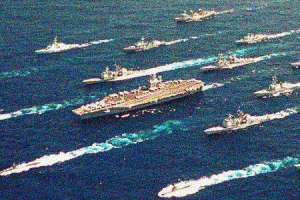 The United States and Israel have been quietly building up their military cooperation. During a visit to Israel last December, General Frank Gorenc announced that thousands of U.S. troops would be deployed to Israel for an exercise that has been code named “Austere Challenge 12.” Additionally, Israel plans on moving a significant number of its troops to a U.S. European Command Headquarters base in Germany.
The United States and Israel have been quietly building up their military cooperation. During a visit to Israel last December, General Frank Gorenc announced that thousands of U.S. troops would be deployed to Israel for an exercise that has been code named “Austere Challenge 12.” Additionally, Israel plans on moving a significant number of its troops to a U.S. European Command Headquarters base in Germany.
These moves come as tensions with Iran have escalated in response to the assassination of an Iranian nuclear scientist last week, the third attack of its kind since 2010. Relations between the United States and Iran began to sour most recently after Iran captured a fallen American drone and refused to return it to the United States. Israel’s Defense Minister Ehud Barak said as early as last November that Israel will not “take any option off the table,” echoing similar statements from the Obama administration. The Revolutionary Guard, Iran’s most elite military branch, has indicated that it will move ships into the Strait of Hormuz in February to conduct training exercises and has already performed some exercises in the strait earlier this month. The U.S. Fifth Fleet, currently based in Bahrain, already has a presence in the area and is in a position to call for additional support from other U.S. ships on anti-piracy missions around the horn of Africa and the Indian Ocean. Britain has announced that it will be sending one of its largest destroyers, HMS Daring, to the strait as well. Together these combined naval forces leave the Iranian navy “significantly outgunned,” according to the Military Times.
Although General Gorenc emphasized to the Jerusalem Post that Austere Challenge 12 is part of a larger U.S. troop deployment, little information is currently available as to how long the Defense Department intends on having U.S. troops stationed in Israel, though Al Jazeera notes that many American servicemen are expected to stay till the end of 2012. The Israeli Air Force is considering setting up a base for an Iron dome counter rocket system near Haifa where it will protect oil refineries in Northern Israel.
As of January 5, debka.com, an Israeli website providing political and security analysis, stated that around 9,000 U.S. soldiers were already on the ground Israel. Austere Challenge 12 will test two separate types of missile defense systems: the land-based Terminal High Altitude Area Defense (THAAD) missile system alongside the naval-operated Aegis system. These systems include both relatively short- range defensive ballistic missile systems such as the Arrow, which Israel produced specifically to defend itself from Iranian attacks, and other systems such as a drone that could be used for a counter-attack or even a pre-emptive attack. This is slated to be the largest missile exercise to date in both U.S. and Israeli history with the long term objective of “establishing joint task forces in the event of a large-scale conflict in the Middle East” in which case this may be the beginning of a long-lasting U.S. military presence in Israel.
Israel isn’t the only U.S. partner in the region beefing up its military capacity. Last month the United States agreed to sell Saudi Arabia $30 billion worth of F15 fighter jets. This followed shortly after the November 2011 sale of nearly 5,000 bunker-busting bombs to the United Arab Emirates. These would prove especially threatening to the UAE’s Persian neighbor as Iran’s alleged illegal nuclear processing plants are located underground well within the range of these munitions.
In a recent development, however, Israel and the United States jointly agreed to postpone Austere Challenge 12 from this April to sometime in the latter half 2012. According to Mark Regev, an Israeli government spokesperson, “The thinking was it was not the right timing now to conduct such an exercise.”
Heath Mitchell is an intern at Foreign Policy in Focus.

